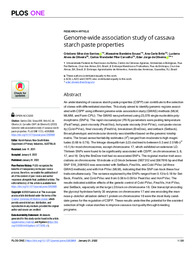Genome-wide association study of cassava starch paste properties.
Genome-wide association study of cassava starch paste properties.
Author(s): SANTOS, C. S. DOS; SOUSA, M. B.; BRITO, A. C.; OLIVEIRA, L. A. de; CARVALHO, C. W. P. de; OLIVEIRA, E. J. de
Summary: An understanding of cassava starch paste properties (CSPP) can contribute to the selection of clones with differentiated starches. This study aimed to identify genomic regions associated with CSPP using different genome-wide association study (GWAS) methods (MLM, MLMM, and Farm-CPU). The GWAS was performed using 23,078 single-nucleotide polymorphisms (SNPs). The rapid viscoanalyzer (RVA) parameters were pasting temperature (PastTemp), peak viscosity (PeakVisc), hot-paste viscosity (Hot-PVisc), cool-paste viscosty (Cold-PVisc), final viscosity (FinalVis), breakdown (BreDow), and setback (Setback). Broad phenotypic and molecular diversity was identified based on the genomic kinship matrix. The broad-sense heritability estimates (h2) ranged from moderate to high magnitudes (0.66 to 0.76). The linkage disequilibrium (LD) declined to between 0.3 and 2.0 Mb (r2<0.1) for most chromosomes, except chromosome 17, which exhibited an extensive LD. Thirteen SNPs were found to be significantly associated with CSPP, on chromosomes 3, 8, 17, and 18. Only the BreDow trait had no associated SNPs. The regional marker-trait associations on chromosome 18 indicate a LD block between 2907312 and 3567816 bp and that SNP S18_3081635 was associated with SetBack, FinalVis, and Cold-PVisc (all three GWAS methods) and with Hot-PVisc (MLM), indicating that this SNP can track these four traits simultaneously. The variance explained by the SNPs ranged from 0.13 to 0.18 for Set-Back, FinalVis, and Cold-PVisc and from 0.06 to 0.09 for PeakVisc and Hot-PVisc. The results indicated additive effects of the genetic control of Cold-PVisc, FinalVis, Hot-PVisc,and SetBack, especially on the large LD block on chromosome 18. One transcript encoding the glycosyl hydrolase family 35 enzymes on chromosome 17 and one encoding the mannose-p-dolichol utilization defect 1 protein on chromosome 18 were the most likely candidate genes for the regulation of CSPP. These results underline the potential for the assisted selection of high-value starches to improve cassava root quality through breeding programs.
Publication year: 2022
Types of publication: Journal article
Unit: Embrapa Cassava & Fruits
Keywords: Cassava starch, Food paste, Fécula, Genoma, Genomics, Mandioca
Observation
Some of Embrapa's publications are published as ePub files. To read them, use or download one of the following free software options to your computer or mobile device. Android: Google Play Books; IOS: iBooks; Windows and Linux: Calibre.
Access other publications
Access the Agricultural Research Database (BDPA) to consult Embrapa's full library collection and records.
Visit Embrapa Bookstore to purchase books and other publications sold by Embrapa.

